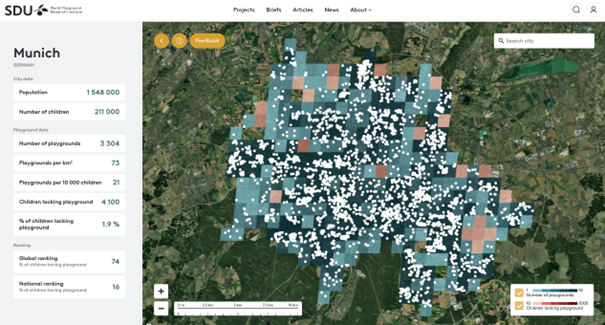Try Playscapes – a new global playground map
How accessible are playgrounds in the world’s cities? Where do children have safe, nearby places to play, move, and meet friends – and where are such spaces missing altogether? A new web-based platform called Playscapes now makes it possible to explore these questions in detail. Developed by researchers at the University of Southern Denmark, the Swedish consultancy Spacescape, and web design firm OAWA, Playscapes allows users to compare playground access across cities worldwide — from a global overview down to the neighborhood level. The tool is freely available to try at playgroundresearch.org/playscapes. It is currently a beta-version for testing, and we kindly ask everyone who tests it for feedback.
On the start page, visitors are greeted with a world map ranking cities according to the share of children with access to a playground. The ranking can be filtered by region, city size, or specific indicators such as the number of playgrounds per square kilometer or the percentage of children without access. The dataset covers every city in the world with more than 50,000 inhabitants — offering a global overview of children’s outdoor environments. Zooming in on a city reveals detailed statistics: the total population, the number of children, the number of playgrounds, and the share of children without access. The city’s global and national ranking is also displayed, providing a quick sense of scale and comparison. Going further, users can view playgrounds as dots on the map, overlaid with a 1×1 km grid that highlights how access varies across different parts of the city. By clicking on a grid cell, one can see the number of playgrounds and children with or without access within that specific area.
The platform is designed to be both intuitive and interactive. Users can zoom, pan, and toggle data layers on and off to explore different levels of detail. Playscapes functions simultaneously as a global benchmarking tool and a local analytical resource, making it relevant for planners, researchers, and communities alike. For urban planners and policymakers, it offers a way to identify underserved neighborhoods, monitor goals related to child-friendly cities, and integrate play data into master plans, green infrastructure strategies, or public space programs. For those involved in park management or playground development, Playscapes can help guide site selection, support funding proposals, and evaluate how play spaces are distributed across the city. Community groups and NGOs can also benefit. By visualizing where playground access is limited, Playscapes supports advocacy, temporary interventions like pop-up playgrounds, and participatory planning with residents. Researchers and educators can use the tool to study patterns of access, compare cities, or teach concepts related to spatial equity, urban health, and open data.
At the same time, the platform highlights data gaps — encouraging municipalities to improve their open datasets and, over time, strengthening the global knowledge base on public spaces and children’s well-being. Behind Playscapes lies a robust methodology combining open and internationally comparable datasets. Playground locations are extracted from OpenStreetMap, while population and demographic data are drawn from Eurostat, the Global Human Settlement Layer (GHSL), and WorldPop. Together, these sources make it possible to analyze children’s access to playgrounds worldwide at a 1 km² resolution. The combination of open data, spatial analysis, and interactive design makes Playscapes a unique digital tool for understanding and improving the everyday environments of children.
Access to play is about much more than recreation. It is about health, equality, and quality of life — about how we plan cities for those who have the least influence but have the greatest need for space. With Playscapes, the world has an open, evidence-based, and globally comparable tool to see where play happens — and where it doesn’t.
Explore the map at playgroundresearch.org/playscapes

